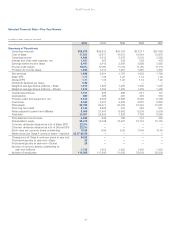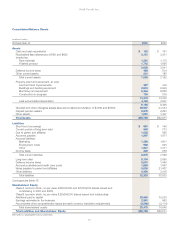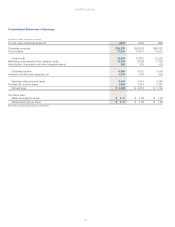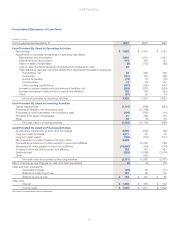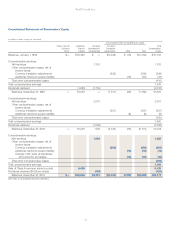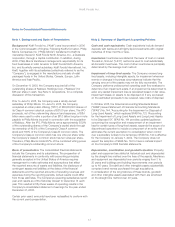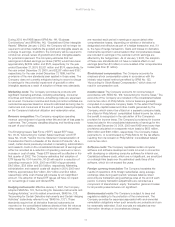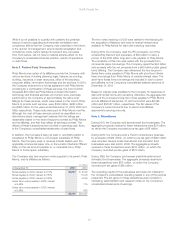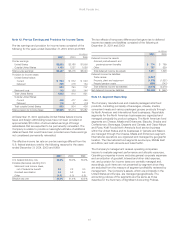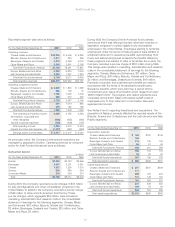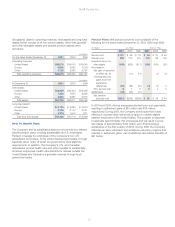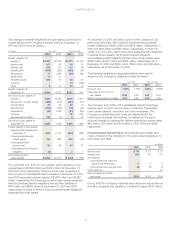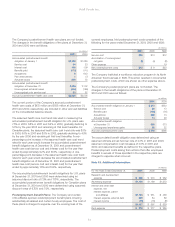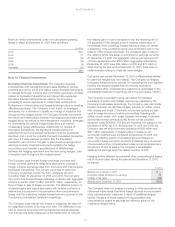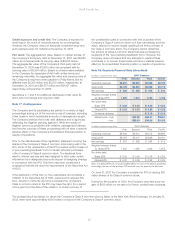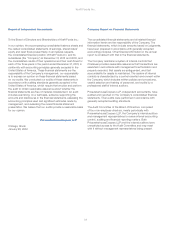Kraft 2001 Annual Report Download - page 53
Download and view the complete annual report
Please find page 53 of the 2001 Kraft annual report below. You can navigate through the pages in the report by either clicking on the pages listed below, or by using the keyword search tool below to find specific information within the annual report.
Kraft Foods Inc.
47
Note 6. Inventories:
The cost of approximately 54% and 56% of inventories in 2001 and
2000, respectively, was determined using the LIFO method. The
stated LIFO amounts of inventories were approximately $150 million
and $171 million higher than the current cost of inventories at
December 31, 2001 and 2000, respectively.
Note 7. Short-Term Borrowings and
Borrowing Arrangements:
At December 31, 2001, the Company had short-term borrowings
of $2,681 million, consisting principally of commercial paper
borrowings with an average year-end interest rate of 1.9%. Of this
amount, the Company reclassified $2.0 billion of the commercial
paper borrowings to long-term debt based upon its intent and
ability to refinance these borrowings. At December 31, 2000, the
Company had short-term borrowings of $146 million with an
average year-end interest rate of 9.2%.
The fair values of the Company’s short-term borrowings at
December 31, 2001 and 2000, based upon current market interest
rates, approximate the amounts disclosed above.
During 2001, the Company entered into agreements for a $2.0
billion 5-year revolving credit facility maturing in July 2006 and a
$4.0 billion 364-day revolving credit facility maturing in July 2002.
The Company intends to use these credit facilities to support
commercial paper borrowings, the proceeds of which will be used
for general corporate purposes. These facilities require the
maintenance of a minimum net worth. None of these facilities were
drawn at December 31, 2001. In addition, the Company maintains
credit lines with a number of lending institutions amounting to
approximately $768 million. The Company maintains these credit
lines primarily to meet the short-term working capital needs of its
international businesses.
Note 8. Long-Term Debt:
At December 31, 2001 and 2000, the Company’s long-term debt
consisted of the following:
(in millions)
2001 2000
Short-term borrowings, reclassified as
long-term debt $2,000 $
—
Notes, 4.63% to 7.55% (average effective
rate 5.95%), due through 2035 6,229 2,751
Debentures, 7.00% to 8.50% (average effective
rate 10.14%), $315 million face amount,
due through 2017 258 401
Foreign currency obligations 136 173
Other 51 83
8,674 3,408
Less current portion of long-term debt (540) (713)
$8,134 $2,695
Aggregate maturities of long-term debt, excluding short-term
borrowings reclassified as long-term debt, are as follows:
(in millions)
2002 $ 540
2003 378
2004 85
2005 730
2006 1,252
2007-2011 2,593
Thereafter 1,153
Based on market quotes, where available, or interest rates currently
available to the Company for issuance of debt with similar terms
and remaining maturities, the aggregate fair value of the Company’s
long-term debt, including the current portion of long-term debt,
at December 31, 2001 and 2000 was $8,679 million and $3,459
million, respectively.
Note 9. Capital Stock:
The Company’s articles of incorporation authorize 3.0 billion shares
of Class A common stock, 2.0 billion shares of Class B common
stock and 500 million shares of preferred stock. At December 31,
2001, there were 555 million Class A common shares and 1.18
billion Class B common shares issued and outstanding, of which
Philip Morris holds 275 million Class A common shares and all of
the Class B common shares. There are no preferred shares issued
and outstanding. Class A common shares are entitled to one vote
each while Class B common shares are entitled to ten votes each.
Therefore, Philip Morris holds 97.7% of the combined voting power
of the Company’s outstanding common stock. At December 31,
2001, 75,949,530 shares of common stock were reserved for stock
options and other stock awards.
Note 10. Stock Plans:
The Company’s Board of Directors has adopted the 2001 Kraft
Performance Incentive Plan (the “Plan”), which was established
concurrently with the IPO. Under the Plan, the Company may grant
stock options, stock appreciation rights, restricted stock, reload
options and other awards based on the Company’s Class A
common stock, as well as performance-based annual and long-
term incentive awards. Up to 75 million shares of the Company’s
Class A common stock may be issued under the Plan. The
Company’s Board of Directors granted options for 21,029,777
shares of Class A common stock concurrent with the closing
date of the IPO (June 13, 2001) at an exercise price equal to the
IPO price of $31.00 per share. A portion of the shares granted
(18,904,637) becomes exercisable on January 31, 2003, and will
expire ten years from the date of the grant. The remainder of the
shares granted (2,125,140) may become exercisable on a schedule
based on total shareholder return for the Company’s Class A
common stock during the three years following the date of the
grant, or will become exercisable five years from the date of
the grant. These options will also expire ten years from the date



